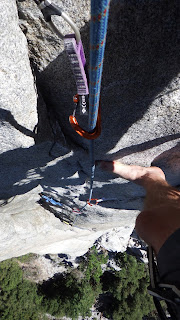The last night in Tuolumne saw me eating some great .... Stuff. The next morning I was to head down into the Valley.
After an afternoon of getting assembled in camp 4, I went the next morning and did the first pitch of the nose, starting with Pine Line as the warmup. There was a fair bit of stuffing around and it was becoming a hot day.
The first pitch is pretty sustained and I was slightly doubtful of being able to get up it, Especially when I came across a slightly run out bit. I often do runout sections on solo, but above a 00 cam and a a small brass offset and with sketchy feet, it didn't feel nice.
Never the less, the pitch went down in a total of about 2 hours with rapping and jumaring as well.
This was a picture of pine line from when I rapped. Pine line is the pitch that get's you to the base of the first pitch but not quite. It is a slick and you still need to manual your gear up the grove to the first pitch.
I was done for the day.
2 days later and I was planning on getting to Sickle Ledge with a fully sleeping gear bag. That is, a bag with a blanket, tarp, emergency blanket, puffy jacket and water. I would see if I could make it work up there or I would come down.
Again, the first pitch went Ok. In fact, much better for having already done it. This time though, I was jumaring with a heavy bag on my back.
The notorious 2nd pitch also went ok, where ok is a relative term based on the number of seconds per minute spent in total stress at thinking your offset nut will pop out.
I looked up at the 3rd pitch which held another solid problem as you needed to step across onto a slopy foothold. Hamish assured me that it would be fine, yet I still procrastinated for an hour, just chilling out before committing to starting the 3rd pitch rather than repelling down and telling everyone that it was a bad idea.
There is a lot of old gear on the route and this cam was no doubt there from previous years. Some of the stuck gear makes one wonder what (if anything) was going through the head of the people placing gear. Still, the more beginners that get higher on the route, the faster that speed climbers will be able to go.
Th third pitch went well after finding a nice small nut to protect the scary step across. There was then just a small runout section that was kind of unexpected but I was headed to sickle ledge, even if for no other reason than that it was the easiest way to repel the route. The free moves when quickly now that I was getting used to scaring myself.
The forth pitch was easy to lead, hard to clean, awkward to jumar, and bloody hard to climb along sickle ledge in approach shoes and a heavy pack.
This is a big step that you need to climb over. It was easy to do on lead and I have done it many times relatively unprotected while seconding, but with a big pack, it sucked.
After the first pendulum on the 4th pitch.
Carrying that heavy bag along the ledge almost busted my right thigh.
The ledge was way too slopey and hard to arrange the tarp for me to consider spending the night.
Time for a break for afternoon tea on the ledge before having to face the 4 long raps to the ground.
This is the new fixed line and anchors to the badly misnamed pitch 5.
Rapping down a blank wall to a set of chains never feels very good. It is like swimming out into the ocean to where you think a boat will be. Then, as you pull the rope, you need to make sure you don't drop it and don't pull it up with a knot in it.
Each repel anchor is not accompanied by a ledge to stand on.
3 more raps gets you to the deck.
Down at last.
You can see sickle ledge on the right of the nose, with the climbing route pretty much strait down the arrete to it's left.































No comments:
Post a Comment